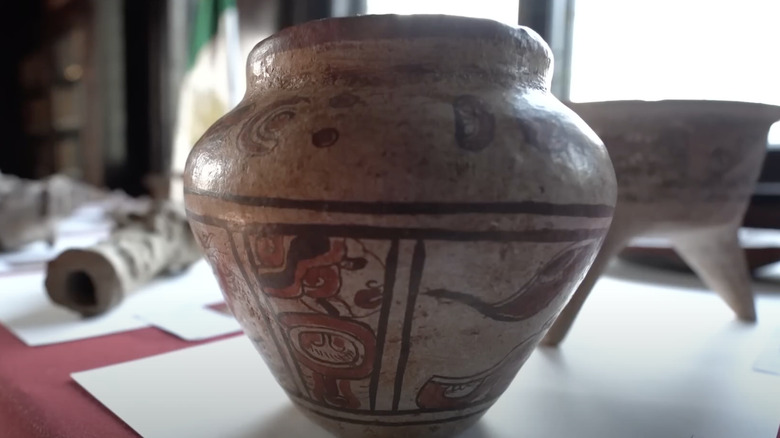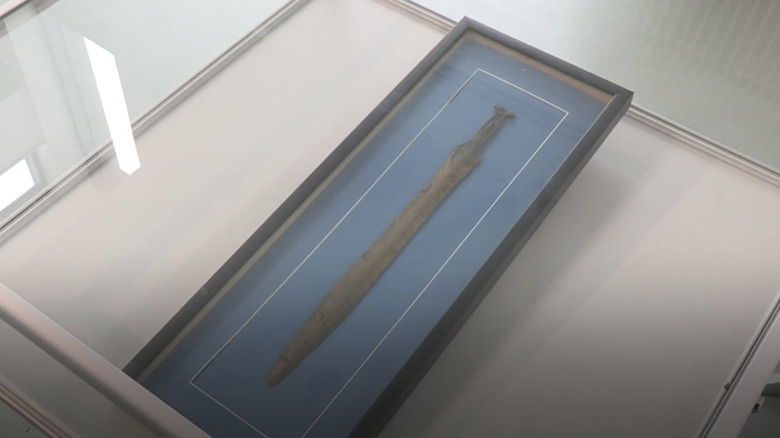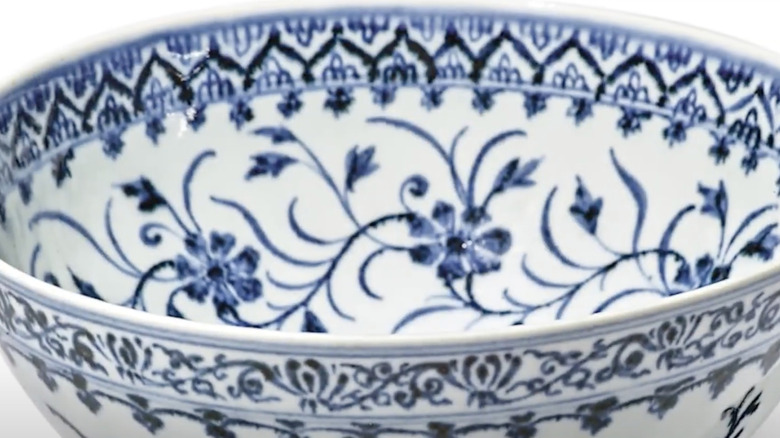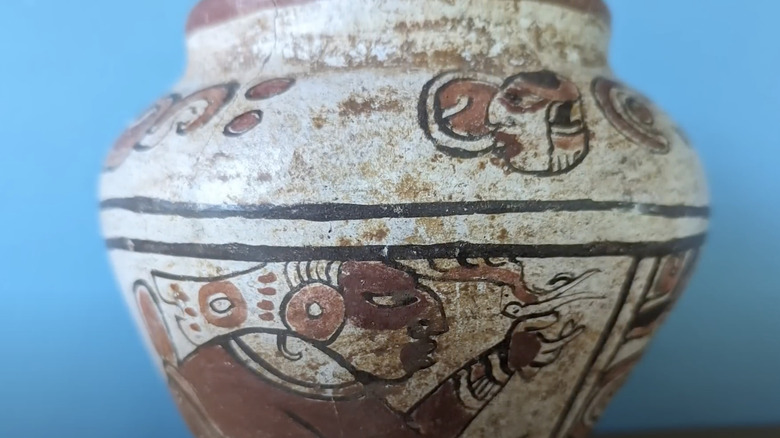Ancient Treasure That People First Mistook For Boring Junk
It's both fascinating and depressing to think about all the relics and gems of antiquity that are probably gone forever. These remnants of history's most important civilizations provide valuable information about what life was like on Earth thousands of years ago. Some were destroyed by natural disasters, others by the armies of rivals, and others still lost to time. Every so often, though, archaeologists do discover some ancient treasure, and it's cause for celebration — that a piece of art or everyday object somehow survived to the present day.
And then, under bizarre and mysterious circumstances, regular people come across a museum-worthy object and proof of life gone by in the most mundane way. They'll find something in a barn, thrift shop, or yard sale and think it's maybe some well-done replica of something worthy — amateur art or just plain nondescript garbage. But it turns out to be far more valuable. Here are some stories of people stumbling upon very old and priceless treasures that they mistook for boring junk.
A Bronze Age sword in a barn
In 1965, Ambrose Owens went fishing by the ford of the Arney River near his home in County Fermanagh, Northern Ireland. Instead of fish, he found what looked like an old sword. Owens got it out of the water, examined it, and then thought so little of it that he threw it into a barn on his family's farm. There it sat for 51 years, until Owens' brother, Maurice, found it and handed it off to Paul Logue. The archeologist was active in a historical society seeking to find the exact spot of the Battle of the Ford of the Biscuits, which took place somewhere along the Arney River in 1594. While there was some speculation that the sword could've been used in that skirmish, it was actually much older: about 2,600 years old.
The Bronze Age began about 5,300 years ago, characterized by humanity's initial attempts to use and utilize metal to make tools and weapons, such as swords, like the one found in Ambrose Owens' barn. "This is only the second time I've ever held a real Bronze Age sword and the significance is amazing," Logue told the BBC. He explained that the weapon was once possessed by a warrior, who broke it before disposing of it in the river, considered a sacred location, as a tribute to a god. "Definitely this didn't belong to your normal lady, your normal bloke, this has come from a high level in society," Logue added.
An ancient Roman bust in a thrift store
"I was just looking for anything that looked interesting," Laura Young told CNN about her August 2018 trip to a Goodwill store near Austin, Texas. She certainly found something: A bust of a man done in the ancient Roman style. Young paid $34.99 for the 52-pound piece, and then she wondered about the lineage of the item. After speaking with various art experts, someone from the Sotheby's auction house told Young that she'd purchased an authentic ancient relic from ancient Rome, where a lot of messed up things happened.
Photos of the piece were found in art digital databases. King Ludwig I of Bavaria had ordered the construction of Pompejanum, a recreation of a home from the Roman city of Pompeii, a city destroyed in a devastating disaster. This bust, which had landed in Aschaffenburg, Germany after many centuries, had been used as a historically accurate decoration. It depicts Sextus Pompey, a high-ranking officer in the Roman military and son of Julius Caesar cohort Pompey the Great. After World War II, the marble sculpture had disappeared from the storage facility where it had been placed for safekeeping, and Young rescued it from obscurity. While it was displayed at the San Antonio Museum of Art for a spell, it was permanently returned to Germany in 2023 and became part of the collection of the Glyptothek, a museum in Munich.
A Ming bowl at a yard sale
In 2020, a man (who chose to keep his name out of news reports) was browsing at a yard sale outside of New Haven, Connecticut, when he opted to buy a small porcelain bowl. It's about 6 inches wide, white, and adorned with elaborate patterns and floral designs painted on in blue. Even though the piece bore some damage around the rim and had suffered a minor chip, the individual paid $35 — fairly steep for a yard sale, but it turned out to be more than worth it.
Seeking more information about the bowl, the buyer sent photographs to the Sotheby's auction house. Appraisers quickly recognized the bowl as coming from the 1403 to 1424 ruling period of the Yongle Emperor, a specific span of the Ming Dynasty of China notable for its new and centuries-enduring techniques in porcelain-based art. The bowl itself was meant to be shaped like a chicken heart or bud of the lotus flower, and the flowers depicted include peonies and chrysanthemums. The purchaser allowed Sotheby's to auction off the item as part of an Important Chinese Art show in March 2021. Valuing the bowl at somewhere between $300,000 and $500,000, the house received a winning bid of $721,800.
A Mayan vase at a thrift store
Back in 2019, Anna Lee Dozier paid $3.99 for a large brown and red painted vase she found in a thrift store near her home in Washington, D.C. "In my work, I travel a lot to Mexico, and this item caught my eye because it looked different than the things on the shelf, but it was also recognizably from Mexico," Dozier told the CBC's "As It Happens." It appeared to be of a certain vintage, but not all that old. "I was thinking a 20- or 30-year-old tourist thing — something someone brought home," she added. Dozier then placed the vase in a room among her books and accumulated treasures.
Five years later, while on a work trip to Mexico City, Dozier visited the National Museum of Anthropology. "As I was walking through, it just occurred to me that some of the things that I was looking at looked very similar to what I had at home," she said. Dozier began a correspondence with the Mexican embassy, and the vase underwent authentication procedures by Mexico's National Institute of Anthropology and History. It wasn't a mass-manufactured trinket replica intended to be a souvenir for travelers — it was a genuine artifact that was made during the heyday of the Mayan civilization, which occupied much of modern Mexico. Dozier's find, crafted sometime between A.D. 200 and 800. Dozier arranged to return the item to Mexico for study and display.
A 4,000-year-old pot at a junk sale
In the U.K., communities come together for group rummage sales called car boot sales, where participants display their wares in the trunks, or boots, of their cars. In 2013, Karl Martin attended such an event in Derbyshire, England, spending £4 on a small, rustic-looking clay pot with an antelope painted on the side. He liked the item enough to buy it, then immediately found a mundane purpose for the jar-like model. "I used it in the bathroom to store my toothpaste and toothbrush — it ended up getting a few toothpaste marks on it," Martin told the BBC.
While Martin worked for Hansons Auctioneers, a house that handles the dealing of all kinds of antiquities, there were some holes in his knowledge. He had no idea of the age or history of his toothbrush holder until five years later, when he was unloading items from a van and saw some pieces that resembled his jar. A coworker explained that those pieces were from the Bronze Age and linked to what is now India, Pakistan, and Afghanistan. Further analysis indicated that Martin's boot sale find was created by an artisan from the Harappan civilization in the Indus Valley sometime around 1900 B.C. Martin auctioned off the work for £80.





